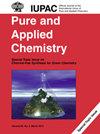阐明催化裂化催化剂组分的相互作用:基质和粘结剂对沸石结构的不同作用
IF 2
4区 化学
Q3 CHEMISTRY, MULTIDISCIPLINARY
引用次数: 0
摘要
沸石 Y 是现代流体催化裂化(FCC)催化剂的活性相。然而,功能性和活性催化裂化催化剂除沸石 Y 外,还包括基质和粘结剂,它们会在催化剂组分之间产生一定程度的协同作用,从而影响催化剂的活性。本研究采用各种表征技术研究了典型催化裂化催化剂上的沸石-基质-粘合剂复合材料的相互作用特性。对合成的催化裂化催化剂样品进行表征后发现,沸石 Y 的结构组成变化取决于粘合剂材料的类型和比例。粘合剂对最终复合材料的结晶非常重要。酸性粘合剂会诱导沸石脱铝,导致非晶化、布氏酸位点的丧失、框架结构受损以及缺陷位点的形成。TEM 显示,沸石与基质结合后形成了沸石-基质界面。根据热加工的程度和严重程度,粘土-氧化铝-二氧化硅粘合剂会通过相邻粘合剂颗粒之间的末端羟基交联而发生不同程度的脱羟基反应,这有助于提高结合催化剂的热稳定性和机械稳定性。本文章由计算机程序翻译,如有差异,请以英文原文为准。
Elucidating the interaction of FCC catalyst components: the discrete roles of matrix and binder on zeolite structure
Zeolite Y is the active phase of the modern fluid catalytic cracking (FCC) catalyst. However, a functional and active FCC catalyst comprises, in addition to zeolite Y, matrices and a binder that introduce some levels of synergistic interaction between the catalyst components, impacting its activity. This study investigates the interactive properties of a zeolite-matrix-binder composite on a typical FCC catalyst using various characterization techniques. Characterization of synthesized FCC catalyst samples reveals changes in the structural composition of zeolite Y dependent upon the type and ratio of binder materials. The binder is important in the crystallization of the final composite. Acidic binder induces dealumination of zeolite, leading to amorphization, loss of Brønsted acid sites, framework structure impairment, and the formation of defective sites. TEM indicates the formation of zeolite-matrix interfaces upon binding of zeolite by the matrix. Depending on the extent and severity of thermal processing, the clay–alumina–silica binder undergoes dehydroxylation to varying degrees by cross-linking of terminal hydroxyl groups between neighboring binder particles, which contributes to the increased thermal and mechanical stability of the bound catalysts.
求助全文
通过发布文献求助,成功后即可免费获取论文全文。
去求助
来源期刊

Pure and Applied Chemistry
化学-化学综合
CiteScore
4.00
自引率
0.00%
发文量
60
审稿时长
3-8 weeks
期刊介绍:
Pure and Applied Chemistry is the official monthly Journal of IUPAC, with responsibility for publishing works arising from those international scientific events and projects that are sponsored and undertaken by the Union. The policy is to publish highly topical and credible works at the forefront of all aspects of pure and applied chemistry, and the attendant goal is to promote widespread acceptance of the Journal as an authoritative and indispensable holding in academic and institutional libraries.
 求助内容:
求助内容: 应助结果提醒方式:
应助结果提醒方式:


